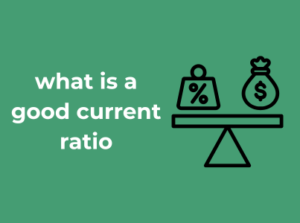Let’s start from square one! The current ratio can sound like a jargon-y financial term, but stick with me, and you’ll see—it’s actually pretty simple and very useful! At its core, the current ratio helps businesses and investors figure out if a company can comfortably handle its short-term liabilities with the assets it currently has. Yep, it’s all about balance.
Picture this: you’re running a small coffee shop. Every month, you need to pay rent, buy coffee beans, pay your baristas, and handle other costs. The current ratio is like your quick check to see if you have enough cash (or anything easily convertible to cash) to pay these bills when they’re due. It’s a snapshot of how comfortably set up a company is to manage its immediate obligations.
What Exactly Is the Current Ratio?
In simple terms, the current ratio compares your current assets to your current liabilities. These terms sound fancy, but essentially:
- Current assets: Things a business owns that can be quickly turned into cash within a year—think cash in hand, accounts receivables (money customers owe you), and inventory.
- Current liabilities: Short-term debts or obligations a business owes—like bills to suppliers, loan payments due soon, and wages payable.
The formula? Easy breezy:
Current Ratio = Current Assets / Current Liabilities
Why Does the Current Ratio Matter?
Knowing your current ratio can spare you a lot of headaches! It’s a key indicator of liquidity, or in plainer terms, the ease with which a company can pay off its debts without breaking a sweat. A solid current ratio signals that a business is financially stable and can comfortably meet its obligations. On the flip side, a poor ratio might be a warning sign of financial trouble—yikes!
What’s the Story the Current Ratio Can Tell?
Think of the current ratio as a financial pulse check. For instance, if the current ratio is greater than 1, that’s usually a good thing because it means the company’s assets outweigh its liabilities. But if it drops below 1—uh-oh!—it might mean the company could struggle to cover its short-term debts. It’s like that feeling when you realize you have tons of bills, but your checking account is looking sad.
A Quick Fun Analogy
Consider a personal example: imagine you’ve got $1,000 in your savings account (your current asset), but your monthly rent and bills come to $800 (your current liabilities). Breathing easy, right? Now imagine you only have $600 saved. Suddenly, you’re on edge and juggling expenses—it’s stressful! That’s essentially what happens when the current ratio drops below 1 for a business.
How to Calculate the Current Ratio: A Quick Guide
Let’s break it down together: calculating the current ratio is much easier than it might seem at first. Whether you’re a seasoned finance pro, a business owner, or just someone getting started with financial metrics, understanding this calculation can demystify a lot about a company’s short-term financial health. I’ll guide you step-by-step and make it as clear as possible.
What Exactly Is the Current Ratio? (Before We Crunch Numbers!)
First, it’s important to understand that the current ratio is a quick snapshot of how prepared a business is to pay off its short-term liabilities (we’re talking debts or obligations due within a year). It does this by comparing those liabilities to the company’s current assets (things like cash, inventory, or accounts receivable).
Think of it like checking if you have enough money in your bank account to cover your monthly bills. It’s not complicated—just a measure of how well-equipped a business is in the short term.

Here’s the Formula (Don’t Worry, It’s Simple!)
The current ratio is calculated as:
Current Ratio = Current Assets ÷ Current Liabilities
That’s all there is to it! No complex algebra or head-scratching formulas. You’re literally dividing one number by another. Let’s dive a bit deeper into what these pieces mean.
Breaking It Down: Current Assets vs. Current Liabilities
- Current Assets: These are all the resources a company can turn into cash within a year. Think cash itself, accounts receivable (money owed by customers), marketable securities, or even inventory. Essentially, anything the company expects to use or convert to cash shortly.
- Current Liabilities: On the flip side, these are all the short-term debts or obligations that must be paid within a year. Common examples include outstanding bills, wages payable, or short-term loans.
So when you’re plugging numbers into the formula, you’re asking, “If we took all the assets ready to go in the next year, would they be enough to handle everything we owe during that time?”
An Example to Bring It to Life
Imagine a company has the following financial details:
- Current Assets: $200,000
- Current Liabilities: $100,000
Using our formula, you would divide $200,000 by $100,000:
Current Ratio = $200,000 ÷ $100,000 = 2.0
This means the company has $2 in assets for every $1 in liabilities. Not too shabby!
Why the Calculation Is Important
Now, you might wonder, “What does this number actually mean for a business?” Well, a higher current ratio typically signifies stronger short-term financial health—though, as we’ll cover elsewhere, too high a ratio can also raise questions. For now, just know that understanding how to calculate this number can help you evaluate a company’s near-term safety net.
What Does ‘Good’ Mean in Terms of Current Ratio?
So, you’ve come across the term “current ratio” and you’ve heard it’s an important figure to assess the financial health of a business. But what does a good current ratio really look like? Well, buckle up because we’re about to break this down in plain, friendly terms so you can walk away feeling like a financial pro.
First, a Quick Recap on What the Current Ratio Actually Is
Let’s keep it simple: the current ratio measures a company’s ability to pay its short-term obligations, like bills or loans, using its short-term assets, like cash or inventory. Mathematically, it’s:
Current Ratio = Current Assets / Current Liabilities
If the result is greater than 1, it means the business has enough assets to cover its liabilities. Less than 1? That could spell trouble. But here’s the thing: not all “greater than 1” current ratios are created equal!
What’s Typically Considered ‘Good’?
A “good” current ratio is often cited as anything between 1.5 and 2.0. This range is considered a sign of solid short-term financial health. Essentially, the company can comfortably pay off its debts while still keeping a cushion of assets. Sounds ideal, right?
But hold on! While this range is helpful as a rule of thumb, context matters a LOT (we’re coming to that soon). What’s good for one business could be overkill—or potentially alarming—for another. Let’s explore that a little further.
When Is a Current Ratio Too High?
That’s right—there is such a thing as having too high a current ratio. If the number exceeds 2.0, it might signal inefficiencies. For instance, the company might be hoarding cash or sitting on too much inventory without reinvesting it wisely to generate growth. After all, cash and other current assets don’t grow on their own—they need to be actively managed to yield returns.
Think of it like personal savings: while it’s smart to have an emergency fund, it wouldn’t make sense to leave all your money sitting idle if it could be earning you interest or creating opportunities somewhere.
When Is a Current Ratio Too Low?
On the flip side, a current ratio consistently below 1.0 is usually a red flag. It means the company’s liabilities outweigh its assets, making it harder to handle short-term debt obligations. This could lead to missed payments, damage to credit ratings, or even bankruptcy in extreme cases. Yikes!
However, some industries operate with traditionally low current ratios. For example, retail businesses or grocery stores often work with slim margins and fast-moving inventory, so a super-high current ratio isn’t always necessary. Context and industry norms play a big role in determining whether a lower ratio is cause for concern or business as usual.
Flexibility Is Key in Defining ‘Good’
A “good” current ratio isn’t something you can slap a universal sticker on. Here are a few things that influence what’s good for one company versus another:
- Industry standards: Manufacturing, tech, healthcare—they all have different norms for what a healthy ratio looks like. (Spoiler alert: we’ll dive deeper into this in heading IV!)
- Growth stage: Startups often take on more liabilities in their early years, so they may have lower current ratios temporarily. Meanwhile, mature companies tend to prioritize stability and have healthier cushions.
- Business model: Companies with rapid cash flow cycles may not need a very high ratio, as they’re quickly generating income to cover expenses. Conversely, businesses with slower cycles might need a buffer.
Industry Benchmarks: Why Context Matters
When it comes to financial ratios, especially the current ratio, it can be tempting to rely on one-size-fits-all advice. However, the truth is that context is everything. What’s considered a “good” current ratio for one company might not necessarily apply to another. This is where **industry benchmarks** come into play—offering valuable insight into how financial performance is assessed specifically for your sector.
Why Industry Benchmarks Are Key
While a widely accepted rule of thumb is that a current ratio of 1.5 to 2.0 is healthy, that metric rarely tells the full story. Companies operate under vastly different conditions depending on their industry, and this impacts their liquidity needs and financial strategies. For example:
- Retail and Consumer Goods: These businesses often maintain lower current ratios because they turn over inventory quickly. Cash flows in regularly, so they don’t need to stockpile assets to cover liabilities.
- Manufacturing: Companies in this sector may hold higher current ratios because they need more working capital to manage raw materials, production cycles, and distribution logistics.
- Tech or Service-Based Companies: These industries may have minimal inventory and more predictable income streams, potentially leading to leaner current ratios.
Simply put, benchmarks help you avoid unfair comparisons. A retail company with a current ratio of 1 may be thriving, while the same metric could signal trouble for a capital-intensive manufacturer.
How to Find Industry Benchmarks
Identifying relevant benchmarks for your sector doesn’t require sleuthing; there are several resources available:
- Research Industry Standards: Many trade associations release annual financial reports that include average ratios for firms within the industry.
- Financial Data Providers: Platforms like Bloomberg, Morningstar, and Dun & Bradstreet publish aggregated financial metrics by sector.
- Competitor Analysis: Public companies in the same sector often disclose their current ratios in financial statements. Compare these metrics while factoring in their size and market position relative to your business.
Taking the time to uncover these benchmarks ensures that you’re interpreting the current ratio in a way that aligns with your unique situation.
Understanding Variability Within Industries
Keep in mind that even within the same industry, a company’s structure or strategy can dramatically impact its ideal current ratio. For instance, established market leaders might comfortably operate with lower ratios, thanks to predictable cash flows and economies of scale. On the flip side, startups and smaller companies might need higher ratios to manage unpredictable financial demands.
Thus, it’s vital to compare your current ratio to businesses that are not only in your industry but also share similar operational characteristics.
Use Benchmarks as a Guide, Not Gospel
Remember, industry benchmarks provide a **general guide** but shouldn’t be treated as an exact prescription. Financial ratios, including the current ratio, are just one piece of the financial health puzzle. Factors like debt levels, market conditions, and even management practices also play significant roles in determining your company’s overall stability.
So, take the time to see where you stand against your peers, but don’t lose sight of the bigger picture. The ultimate goal is financial resilience and growth, not just hitting a specific number.
The Role of Current Ratio in Assessing Financial Health
Hello there! Let’s dive into one of the most crucial aspects of financial analysis: the current ratio, and specifically, how it plays a key role in assessing the financial health of a business. Don’t worry, I’m here to guide you through it in a simple, approachable way!
What Exactly Is the Current Ratio?
Before we fully explore its role, it helps to understand the current ratio on a basic level. This financial metric compares a company’s current assets (like cash, accounts receivable, and inventory) to its current liabilities (such as accounts payable, short-term debts, and accrued expenses). It tells us how capable a business is at covering its short-term obligations—essentially, its liquidity health check!
A quick refresher on the formula:
Current Ratio = Current Assets / Current Liabilities
Why Is It So Important?
The current ratio is a cornerstone of assessing financial health because it reflects a company’s ability to meet short-term financial obligations. Think of it as a stress test for liquidity. Investors, creditors, and management teams all keep an eye on this number to gauge the company’s short-term stability.
But that’s just the start! The current ratio helps answer questions like, “Can this business pay off its debts without scrambling for last-minute funding?” and “Does this company have enough wiggle room for unexpected challenges?” A company with an excessively low current ratio may struggle to stay afloat in the short term, while one that’s too high could be holding onto inefficient or unnecessary cash reserves.
Signs of a Healthy Balance
Here’s where it gets fascinating. While a current ratio of 1 or above is generally considered “safe,” the ideal figure can vary depending on context—but more on that in another section. For now, let’s explore how this metric demonstrates financial health:
- Ability to Meet Obligations: A business that consistently maintains an adequate current ratio is seen as reliable. It signals they’re well-prepared to handle short-term liabilities using their liquid resources.
- Operational Efficiency: A balanced current ratio indicates that a company is managing its working capital effectively. It’s not hoarding, nor is it running dangerously lean.
- Enhanced Credibility: Banks, lenders, and suppliers use the current ratio when deciding whether to extend credit or offer favorable terms to a company. Who doesn’t want to look attractive to potential partners?
Common Mistakes When Interpreting Current Ratios
Understanding the current ratio is vital for gauging a company’s financial health, but interpreting it is not as straightforward as it might seem. Being misled by oversimplified analyses can lead to faulty conclusions, and no one wants that. Let’s dive into some common pitfalls and how you can avoid them, ensuring your financial insights are rock-solid.
1. Viewing the Current Ratio in Isolation
One of the most frequent mistakes is focusing solely on the current ratio without considering other financial metrics or the broader context. Sure, the current ratio tells you how well a company can meet its short-term obligations, but it doesn’t give the full picture. Think of it like describing a movie by only watching the trailer—it leaves out so much critical information!
For example, a high current ratio might seem great, but if it’s due to excessive inventory that isn’t selling, that could be a warning sign. Pair the current ratio with other metrics like inventory turnover or quick ratio to get a clearer view.
2. Assuming ‘Higher’ Means ‘Better’
It’s tempting to believe that a higher number always equals better performance. A current ratio of 2:1 (or 2.0) is often considered the gold standard, but going significantly higher than this isn’t necessarily ideal. Why? It could indicate inefficiency, such as holding too much cash or stockpiling inventory.
The takeaway? Don’t blindly celebrate every high ratio—scrutinize what it represents. A balance between liquidity and operational efficiency is usually a better indicator of financial health.
3. Neglecting Industry Context
A critical mistake is applying a one-size-fits-all interpretation to the current ratio across different industries. The ‘ideal’ ratio can vary widely depending on the sector. For instance:
- Manufacturing companies may require a higher ratio due to holding larger inventories.
- Service-oriented businesses can operate effectively with a lower ratio since they don’t deal with much inventory or many receivables.
- Retailers often aim for a healthy middle ground, balancing stock and cash flow.
Comparing a tech startup’s ratio against a retail giant’s is like comparing apples to oranges. Always factor in the nature of the business.
4. Overlooking the Quality of Assets
The numerator in the current ratio—current assets—might look strong on paper, but what’s the composition of those assets? Are they liquid enough to meet liabilities when needed? For instance, accounts receivable that are unlikely to be collected within the payment terms inflate the ratio without adding real value.
Similarly, inventory that’s obsolete or slow to sell can distort the ratio. When analyzing, dig deeper into the makeup of those current assets to ensure they’re genuinely helping the business, not just creating a façade of financial stability.
5. Ignoring Historical Trends
Another common oversight is failing to look at trends over time. A single snapshot of the current ratio can be misleading, especially if a company is undergoing significant changes. Is the ratio improving, declining, or stable over the years? Trends provide invaluable insight into whether the company is moving in the right direction.
For example, a single low current ratio might seem alarming, but if it’s improving consistently from quarter to quarter, that’s a positive sign of better management and growth.
How to Improve Your Current Ratio Effectively
Improving your current ratio doesn’t have to be a daunting task. In fact, it’s all about making smart decisions and taking steady steps toward better financial health. Let’s break it down together and explore how you can enhance this important metric with practical, effective strategies.

1. Cut Down on Short-Term Liabilities
One of the simplest ways to improve your current ratio is to focus on reducing your short-term liabilities. Here’s the thing: liabilities like credit card debts, short-term loans, or outstanding supplier invoices can weigh down your ratio significantly. By prioritizing these payments and negotiating better payment terms with lenders or vendors, you can give your ratio a healthy boost. Think of it as clearing out financial clutter so your business can breathe easier.
2. Build Up Current Assets Strategically
On the flip side, increasing your current assets is another great way to see improvement. Assets like cash, receivables, and inventory play a huge role in balancing out your ratio. Could you increase sales or collect receivables faster? Maybe liquidating slow-moving inventory is an option? Focus on actions that enhance your cash flow and make your assets work smarter for you.
3. Optimize Inventory Management
Speaking of inventory, it’s a key player when it comes to current assets. Holding too much unsold inventory can tie up valuable resources, while too little could harm operations. The goal here is balance. Investing in an efficient inventory management system allows you to better align inventory levels with demand. Not only does this improve your current ratio, but it can also drive overall operational efficiency.
4. Refine Your Credit Policy
If your business provides goods or services on credit, analyzing and refining your credit policy is crucial. Are clients taking too long to pay? Revisiting payment terms and conducting credit checks on new customers can go a long way. A well-structured credit policy encourages faster payment and ensures you’re not left waiting for funds that could improve your liquidity.
5. Consolidate or Restructure Short-Term Debt
Sometimes, short-term liabilities can feel overwhelming. Consider talking to financial advisors or lenders about consolidating debt or renegotiating terms to extend repayment periods. For instance, converting short-term obligations into longer-term ones (if feasible) can spread out payments, easing pressure on your ratio. Pro tip: make sure this aligns with your business goals and won’t create new financial hurdles.
6. Be Proactive with Cash Flow Management
Your current ratio is essentially a snapshot of your company’s liquidity, so managing cash effectively is non-negotiable. Regularly review your cash inflows and outflows to identify areas where you can cut costs or improve efficiency. Tools like cash flow forecasting software can help you stay on top of things and adjust spending in real time.
7. Plan for the Long Term, Adjust the Short Term
Lastly, remember that improving your current ratio isn’t just about quick fixes—it’s also about strategic, long-term planning. Factor this metric into your financial goals, and avoid band-aid solutions that could hurt your business later. Sometimes, small, consistent changes make the biggest impact.






